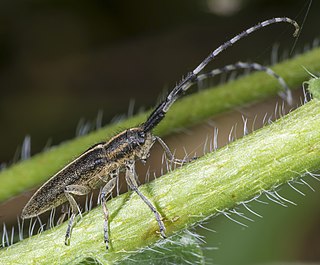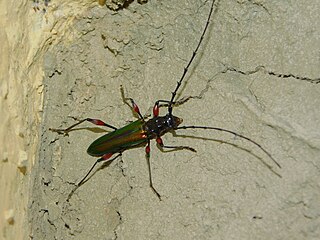
Lamiinae, commonly called flat-faced longhorns, are a subfamily of the longhorn beetle family (Cerambycidae). The subfamily includes over 750 genera, rivaled in diversity within the family only by the subfamily Cerambycinae.

Batocera is a genus of the family Cerambycidae, subfamily Lamiinae, close to the genus Rosenbergia.

Clytini is a tribe of beetles in the subfamily Cerambycinae, containing the following genera:

Trachyderini is a tribe of long-horned beetles in the family Cerambycidae. There are at least 140 genera and 650 described species in Trachyderini.

Tragidion is a genus of beetles in the family Cerambycidae, containing the following species:

Agapanthiini is a tribe of longhorn beetles of the subfamily Lamiinae.

Desmiphorini is a tribe of longhorn beetles of the subfamily Lamiinae.

Lamiini is a tribe of longhorn beetles of the subfamily Lamiinae.
Cathexis is a genus of Long-Horned Beetles in the beetle family Cerambycidae. There are at least two described species in Cathexis, found in Brazil and Argentina.
Enotes is a genus of flat-faced longhorns in the beetle family Cerambycidae. This genus has a single species, Enotes lifuanus, found in New Caledonia.
Domitia is a genus of Long-Horned Beetles in the beetle family Cerambycidae. There are about seven described species in Domitia, found in Sub-Saharan Africa.

Cordylomera is a genus of longhorn beetles in the family Cerambycidae. There are more than 30 described species in Cordylomera. They are found mainly in Africa, and Cordylomera spinicornis is also found in Europe and Temperate Asia.
Domitia aenea is a species of long-horned beetle in the family Cerambycidae. It is found in Ghana, Guinea, and Ivory Coast.
Domitia cervina is a species of flat-faced longhorns in the beetle family Cerambycidae. It is found in Angola, DR Congo, Gabon, Central African Republic, and Republic of the Congo.
Domitia marshalli is a species of flat-faced longhorns in the beetle family Cerambycidae. It is found in the Central African Republic, Republic of the Congo, Cameroon, and DR Congo.
Domitia viridipennis is a species of flat-faced longhorns in the beetle family Cerambycidae. It is found in Cameroon and Nigeria.
Linda scopigera is a species of flat-faced longhorn in the beetle family Cerambycidae.
Planodema scorta is a species of beetle in the family Cerambycidae. It was described by James Thomson in 1858, originally under the genus Domitia.
Domitia basilewskyi is a species of flat-faced longhorns in the beetle family Cerambycidae. It is found in Rwanda.
Domitia bomansi is a species of flat-faced longhorns in the beetle family Cerambycidae. It is found in DR Congo.








